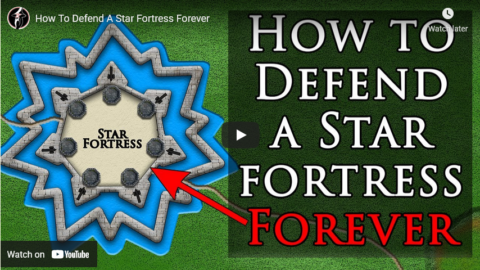SandRhoman History
Published 13 Jun 2021Thanks to Audible for sponsoring this video! Start listening with a 30-day Audible trial. Choose one audiobook and two Audible Originals absolutely free: http://audible.com/sandrhoman or text sandrhoman to 500-500.
In this video we will provide you with the most necessary knowledge to defend a star fortress forever.
Patreon (thank you): https://www.patreon.com/sandrhomanhis…
Paypal (thank you: paypal.me/SandRhomanhistory
We also have Twitter: https://twitter.com/Sandrhoman#history #siege #sandrhoman
Sources:
Hoppe, S., s.v. “Festungsbau”, in: Enzyklopädie der Neuzeit.
Lynn, J. A., “States in Conflict 1661-1763”, in: Parker, G. (Ed.), The Cambridge History of Warfare, Cambridge 2005.
Lynn, J. A., “The trace itallienne and the Growth of Armies”, in: Rogers, C. J. (Ed.), The Military Revolution Debate. Readings on the Military Transformation of Early Modern Europe, Boulder / San Francisco / Oxford 1995.
Ortenburg, G., Waffe und Waffengebrauch im Zeitalter der Landsknechte (Heerwesen der Neuzeit, Abt. 1, Bd. 1) Koblenz 1984.
Parker, G., “The Limits to Revolutions in Military Affairs: Maurice of Nassau, the Battle of Nieuwpoort (1600), and the Legacy”, in The Journal of Military History, 71;2, 2007; S. 331 – 372.
Rogers, C.J. / Tallet F. (editors), European Warfare, 1350–1750, 2010.
Van Nimwegen, O., The Dutch Army and the Military Revolutions, 1588-1688.
June 14, 2021
How To Defend A Star Fortress Forever
Movies based on “classic literature”
Severian considers the relative glut of movies more-or-less based on the classics of literature from his formative years:
When I was a young buck, there was a fad for making movies out of “classic literature”. Scads of chick flicks, of course — Jane Austen’s complete works, the Brontës, and so on — but they also took a stab at Shakespeare. Mostly they stuck to the comedies — and trust me, watching Keanu Reeves trying to handle Much Ado About Nothing is hilarious, in all the wrong ways — but they’d occasionally give the tragedies a shot. Kenneth Branagh’s Hamlet is pretty good despite all the distracting cameos, his Othello is at least sincere (ye gods, imagine trying to make that today!), I think I’m forgetting a few. Mel Gibson gave Hamlet a go back in the early 1990s, and so on. Again, I’m pretty sure I’m forgetting a few.
It always struck me as odd. Unless they timed the theatrical releases to midterm and finals week, hoping to hoover up the dollars of desperate sophomores who didn’t do the homework, it didn’t make much sense, marketing-wise. We were a much more culturally literate people once, it’s true*, but there’s just not much of an audience for the Bard anymore. Nor was it a case of SJWs trying to destroy something good just on general principles. I’m sure Gwyneth Paltrow was bad as Emma, but the idea of retconning every single female in the Western Canon into a Strong, Confident Woman(TM) was still in its infancy. My only other guess was that, since college enrollments were skyrocketing, maybe the parents of all those first-gen college kids were feeling mal-educated and trying to catch up …? Lame, I know, but it was the best I could do.
Looking back on it now, I see my problem: I was looking at it from the demand side. Silly and naive as I was, I assumed that Hollywood’s primary concern was making money, so they went out and found what the people wanted to see, then gave it to them. For instance, I thought Titanic was going to be a huge flop. I mean, the boat sinks. We know that. How do you squeeze any dramatic tension out of it? I should’ve realized they’d be playing it as a doomed-lovers tragedy — girls love that shit, what with the big flouncy costumes and all. Once I realized that, I thought I had it all figured out — every girl I, personally, knew found the works of Jane Austen tedious, but that’s because (I reasoned) you have to supply the images for yourself. Put Hunky McBeef up there in breeches and a peruke, Waify Beecup in a Regency dress, and it’s chick crack …
Or so I thought. Looking back on it now, that’s as dumb as my opinion that Titanic would bomb. Hollywood doesn’t care what you want. I doubt if Hollywood has ever cared what you want, but if they ever did, that time probably ended in tandem with Clara Bow’s career. Hollywood wants what they want, and so will you, because whaddaya gonna do, not watch it? The reason they made all those “classic literature” films in the 1990s, then, wasn’t because they thought we wanted (or needed) some cultural uplift.
No, the reason was: By the 1990s, the last of the old guard in Hollywood was dying off, replaced by the new guard, the Baby Boomers. As we know, it’s not enough for Boomers to control everything while making a shitload of money. No no, for them everything has to be deep and meaningful. They thought of themselves as artistes, not entertainers, so they had to put out a bunch of highbrow stuff, and we had to watch it. This is the sole reason goofy-looking Kenneth Branagh and his horse-faced wife (at the time) were a big cultural force. They made Shakespeare sexy, by which I mean, they allowed the studio heads to think of themselves as the arbiters of culture, not the carny trash they were and are. That some decent movies got made because of it, is entirely incidental.**
*Last summer, during the worst of lockdown mania, I introduced my little nephews to Bugs Bunny. The real ones, from the 40s and 50s, not the crap they put out ten, twenty years ago. I am an educated man by modern standards, but a lot of that stuff flew over my head … and they used to show these in front of popular movies, on military bases, etc.! There’s the classic Wagner one, of course — kill da wabbit!! — but another one involves The Barber of Seville, which I haven’t seen performed and had to look up. Even the “throwaway” music was classical — they could assume, in other words, that your average workaday guy or GI had a fairly large repertoire of classical pieces in his head, enough to recognize bits from Strauss, Chopin, Schumann, etc.
**I do kinda regret bashing Sir Kenneth, as wiki tells me he now is. I enjoyed Hamlet (again, despite the annoying cameos), and some of his other work was pretty entertaining, even, in a limited way, visionary — a quirky little picture like Dead Again didn’t do much in 1991, but it would clean up now (a PoMo costume drama!). I’m one of the few people who liked Mary Shelley’s Frankenstein, which again despite terrible casting (Robert De Niro? Seriously?) was loads of fun. Shelley’s novel as written is ludicrous, therefore unfilmable, but Branagh admirably captured the spirit of it. It’s as Goth as can be, in the original sense of “Gothic”. Wonderful stuff.
The Welsh Flag: History and Meaning of The Red Dragon Flag
History With Hilbert
Published 16 May 2018You may think it’s a bit odd that I’m making a video in the Union Flag Series about the Welsh flag, given that it’s the only part of the United Kingdom not represented on the country’s flag. However Wales is great, and its flag has some interesting history and symbolism so you’re just going to have to deal with it. In this one I’ll be look at the Welsh Dragon Flag, at the figures of Cadwalladr ap Cadwallon (and his dad), Owain Glyndŵr, Henry VII and many more.
Music Used:
“Sneaky Snitch” – Kevin MacLeod
“Teller of the Tales” – Kevin MacLeod
“Up and Away” – Holfix
https://www.youtube.com/watch?v=9YmM_…
“Celtic Impulse” – Kevin MacLeod (incompetech.com)
Licensed under Creative Commons: By Attribution 3.0 LicenseAll images are from the Public Domain of Wikimedia Commons and Pixabay with the following exception:
Owain Glyndŵr’s Flag – Hogyncymru:
https://creativecommons.org/licenses/…
QotD: Obsolescent carrier aircraft in the Pacific war
The most obsolete first-line strike aircraft in any carrier force in 1942 was the American Douglas TBD Devastator torpedo bomber (206mph, 2 x.303 mg. 1,000lbs of a torpedo or bombs, range 716 miles). Despite — or because of — being the first monoplane on any carrier air-wing (1937!), it had never been a very good aircraft. Fully loaded with a torpedo (a much lighter torpedo than used by anyone else), it had a hard time getting off the deck, and had a much reduced speed and range. In fact its attack speed was actually slower than a [British Fairey] Swordfish, and it lacked the Swordfish’s maneouvrability or capacity to take damage. Used in daylight (the only way it could be used), it was an absolute death-trap if there was any airborne opposition at all. In fact the role played by the Devastators at the Battle of Midway was as [unintentional] kamikaze decoy targets to draw the Japanese fighter forces out of place. A point made even clearer by the fact that the few Devastators which had managed to attack at Coral Sea had usually seen their torpedoes fail to work anyway. (The American carrier fleet would not get a successful airborne torpedo until mid 1943!)
The next most obsolete was the Japanese Aichi D3A “Val” dive-bomber (266mph, 3 x 7.7 mg, 1 x 500lb and 2 x 60lb bombs, 970 mile range) which had also entered service in the mid 30’s. It was a fixed landing gear dive-bomber modeled on the famous Junkers Ju87 (183mph, 1 x 7.7mm mg, 1,000lb bomb load, 621 mile range), and was just as good a dive bomber … if there was no opposition. Unlike the Ju87 (and like the [British Blackburn] Skua) the Val also had the ability to defend itself as a second-rate fighter once the bombs had been dropped. Still, the Val relied for success on clear skies, and achieved excellent results under those conditions at Ceylon (cruisers Devonshire and Cornwall and unarmed old carrier Hermes) and Coral Sea (carrier Lexington). Under even moderate air pressure at Trincomalee and Midway the performance fell off markedly, and later in the war the phrase that comes to mind is “Great Marianas Turkey Shoot”. Nonetheless they had to soldier on because the replacement aircraft was too fast for the smaller carriers that were to become the majority of the Japanese carrier fleet after Midway.
Nigel Davies, “Comparing naval aircraft of World War II”, rethinking history, 2010-12-20.






